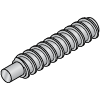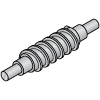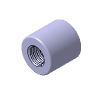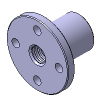(!)NOTE : Windows 7 users won’t be able to use some latest features of eCatalog/WOS since Microsoft is ending support for Windows 7 on 14 Jan, 2020. Please upgrade your system for uninterrupted services.
- Scheduled Maintenance Notice: This site will be unavailable due to scheduled maintenance from 6:30 24/11/2024 to 4:30 (IST) 25/11/2024. We apologize for the inconvenience.
- Please note that the MISUMI Pune office and warehouse will be closed on November 20th due to the state election.
- Notice of End of Sales for Economy Series Pneumatic Equipment Category. More information.
Lead Screws, Nuts
Lead screws and nuts are mechanical components used to convert rotational motion into linear motion. A lead screw resembles a threaded rod with a helical groove, while the nut is a component that engages with the threads of the lead screw. As the lead screw rotates, the nut moves along its length, translating the rotational motion into linear movement. These components find widespread use in various applications such as CNC machines, 3D printers, robotics, and positioning systems. They are available in different materials, thread profiles, and sizes to accommodate specific requirements for load capacity, speed, precision, and environmental conditions. Overall, lead screws and nuts are essential for facilitating precise and controlled linear motion in mechanical systems. To select lead screws and nuts from MISUMI, navigate our website, browse the relevant section, use filters to narrow options by size and material, compare products based on specifications, availability, and place your order.
Brand |
|
|---|---|
| CAD |
|
| Days to Ship |
|
1 items
- Sort By
-
You can add up to 6 items per a category to the compare list.
![[Clean & Pack]Lead Screws - Both Ends Stepped](//content.misumi-ec.com/image/upload/f_auto,q_auto,t_product_view_b/t_misumi_wm/v1/p/jp/product/series/110310646919/110310646919_001_20230911105917.jpg?$product_view_b$)
[Clean & Pack]Lead Screws - Both Ends Stepped
MISUMI
Three types of cleaning methods are available: degreasing, precision cleaning, and electrolytic polishing + precision cleaning. They can be ordered from one piece with the standard part number.
This eliminates the need for customer cleaning or outsourced cleaning, reducing the amount of time and effort required.■Part Number for Clean & Pack Products·Degreasing (Anti-rust single packing) : Part Number SL-□□ ·Precision cleaning (Degassing double packing) : Part Number SH-□□ ·Electrolytic polishing + precision cleaning (Degassing double packing) : Part Number SHD-□□ Product Part Number Cleaning Method Packaging Type Effects Compared to Uncleaned Product Environment (Standard) Process SL-□□ Degreasing Anti-rust packing Oil removal General environment Regular assembly process Post battery assembly process SH-□□ Precision cleaning Degassing double packing Oil removal
Dust removalClean environment (Class 10 to 1,000) Battery assembly process LCD-related post-assembly process In-vehicle camera assembly process SHD-□□ Electrolytic polishing + precision cleaning Degassing double packing Oil removal
Dust removal
Outgas reductionVacuum environment
Clean environment (Class 10 to 1,000)Pre-semiconductor process Liquid crystal deposition process Pre-OLED process ■Notes
Cleaning also removes rust prevention oil, which may make the product more susceptible to rusting than an uncleaned product.
Please be careful about the application location and storage environment.Shaft Shape Nominal of Thread D(Ø) Thread Position Thread Pitch(mm) Shaft Material Shaft Surface Treatment Type Tolerance of Central Part (Incomplete Threaded Portion) Screw Nut Shape Screw Nut Material Screw Nut Outer Dia. D(Ø) Screw Nut Length L(mm) Both Ends Stepped 16 Right-Hand Thread / Left-Hand Thread (3) - - Lead Screw - - - - - Days to Ship: 12 Day(s) or more  12 Day(s) or more
12 Day(s) or more
| Brand |
|---|
| Product Series |
| From |
| Days to Ship |
| Shaft Shape |
| Nominal of Thread D(Ø) |
| Thread Position |
| Thread Pitch(mm) |
| Shaft Material |
| Shaft Surface Treatment |
| Type |
| Tolerance of Central Part (Incomplete Threaded Portion) |
| Screw Nut Shape |
| Screw Nut Material |
| Screw Nut Outer Dia. D(Ø) |
| Screw Nut Length L(mm) |
You can add up to 6 items per a category to the compare list. | |
| Brand | MISUMI |
| Product Series | |
| From | |
| Days to Ship | 12 Day(s) or more |
| Shaft Shape | Both Ends Stepped |
| Nominal of Thread D(Ø) | 16 |
| Thread Position | Right-Hand Thread / Left-Hand Thread |
| Thread Pitch(mm) | (3) |
| Shaft Material | - |
| Shaft Surface Treatment | - |
| Type | Lead Screw |
| Tolerance of Central Part (Incomplete Threaded Portion) | - |
| Screw Nut Shape | - |
| Screw Nut Material | - |
| Screw Nut Outer Dia. D(Ø) | - |
| Screw Nut Length L(mm) | - |
Loading...
Configure
Specification/Dimensions
-
Shaft Shape
-
 Straight
Straight -
 One End Stepped
One End Stepped -
 One End Double Stepped
One End Double Stepped -
 Both Ends Stepped
Both Ends Stepped -
 One End Stepped, One End Double Stepped
One End Stepped, One End Double Stepped -
 Both Ends Double Stepped
Both Ends Double Stepped
-
-
Nominal of Thread D(Ø)
-
Thread Position
- Right-Hand Thread
- Left-Hand Thread
- Right and Left-Hand Thread
- Precision Right and Left-Hand Thread
-
Thread Pitch(mm)
-
Shaft Material
- Steel
- Stainless Steel
-
Shaft Surface Treatment
- Not Provided
- Low Temperature Black Chrome Plating
- Black Oxide
-
Type
- Lead Screw
- Screw Nuts
-
Tolerance of Central Part (Incomplete Threaded Portion)
-
Screw Nut Shape
-
Screw Nut Material
-
Screw Nut Outer Dia. D(Ø)
-
Screw Nut Length L(mm)
Related Categories to Lead Screws, Nuts
FAQ Lead Screws, Nuts
- Question: How do lead screws and ball screws differ in their applications and efficiency?
- Answer: Lead screws and ball screws differ in their applications and efficiency due to design variations. Lead screws, using a threaded shaft and nut, suit low-speed, low-precision tasks like manual adjustments. They typically exhibit lower efficiency due to higher friction. In contrast, ball screws integrate ball bearings between the screw and nut, enhancing efficiency, precision, and speed. Consequently, ball screws find favor in high-precision, high-speed applications such as CNC machining, robotics, and aerospace systems where smooth, precise motion is critical, offering superior performance compared to lead screws.
- Question: What should be considered when choosing the size of a lead screw for a specific application?
- Answer: When choosing a lead screw size for an application, consider factors like load capacity, speed, and precision requirements. Determine the necessary length, pitch, and lead based on travel distance and desired linear speed. Ensure proper end support and mounting arrangements to prevent instability. Also, consider environmental conditions, material choice, coating, and acceptable backlash levels. By carefully weighing these aspects, you can select the appropriate lead screw size to ensure optimal performance and reliability for your specific application.
- Question: What are the advantages of using a 30-degree trapezoidal lead screw with a double-end step?
- Answer: Using a 30-degree trapezoidal lead screw with a double-end step offers numerous benefits. These include enhanced load capacity, improved stability, reduced backlash for precise positioning, increased efficiency due to smoother operation, and versatility allowing for flexible design options utilizing both ends. Overall, this configuration provides strength, stability, precision, and adaptability, making it ideal for a wide range of industrial and mechanical applications requiring reliable and precise linear motion.
- Question: What are the different types of lead screws?
- Answer: Lead screws come in various configurations based on thread design, number of starts, and material:
Thread design: Acme threads are the most common, offering a good balance of strength and efficiency. Other options include buttress threads for high axial loads and metric threads for international standards.
Number of starts: A single-start lead screw translates one rotation into the distance of one thread (pitch). Multi-start screws (double, triple, etc.) have multiple threads that move simultaneously, resulting in faster linear travel per rotation.
Material: Lead screws are typically made from steel or stainless steel for strength and durability. Polymer options can be used for lighter weight and corrosion resistance in some applications. - Question: What factors should be considered when selecting a lead screw for high-load applications?
- Answer: When selecting a lead screw for high-load applications, factors such as load capacity, material strength, diameter, pitch, nut design, and lubrication must be considered. The lead screw should withstand the anticipated load without deformation, requiring a material with high tensile strength and a robust nut design. A larger diameter and coarser pitch help distribute the load effectively, minimizing deflection. Proper lubrication reduces friction and wear, prolonging the lead screw's lifespan under high-load conditions, ensuring reliable performance in demanding applications.
![[Clean & Pack]Lead Screws - Both Ends Stepped](http://content.misumi-ec.com/image/upload/f_auto,q_auto,t_product_view_b/t_misumi_wm/v1/p/jp/product/series/110310646919/110310646919_001_20230911105917.jpg?$product_view_b$)
![[Clean & Pack]Lead Screws - Both Ends Stepped](http://content.misumi-ec.com/image/upload/f_auto,q_auto,t_product_view_c/t_misumi_wm/v1/p/jp/product/series/110310646919/110310646919_001_20230911105917.jpg?$product_view_c$)











How can we improve?
How can we improve?
Thank you for your time.
Your feedback is essential for our continuous improvement
Privacy Policy
Thank you for your cooperation.
Thank you for your time.
Your feedback is essential for our continuous improvement
Please use the inquiry form.
Privacy Policy